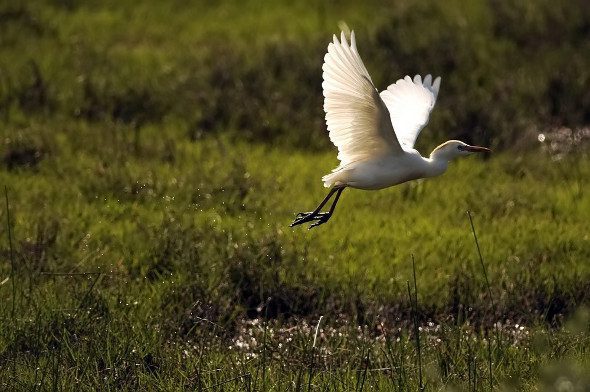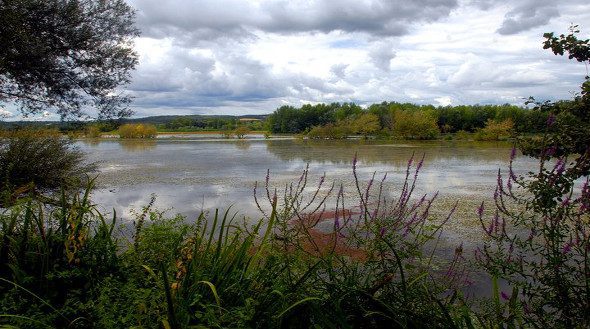
L’Oasi di Alviano è stata istituita nel 1978 su un’area di 800 ettari e inserita nel Parco fluviale del Tevere, comprende l’intero bacino artificiale del lago di Alviano, formatosi nel 1960 con lo sbarramento del Tevere finalizzato alla produzione di energia elettrica, già da allora il lago richiamava migliaia di uccelli in migrazione.
Dal 1990 il WWF vi gestisce una riserva faunistica, in un contesto ricco dal punto di vista della vegetazione sia ripariale che palustre.
L’oasi interessa i comuni di Alviano, Guardea e Montecchio. Quattro chilometri di percorso natura si dipartono dall’ingresso che si trova a Madonna del Porto nel comune di Guardea, divisi in due itinerari.
All’interno dell’oasi si può praticare il “birdwatching” con appostamenti su torri, passerelle con capanni ben attrezzati, vi è pure un’aula scolastica all’aperto proprio in mezzo alla palude.
Essendo una zona umida e paludosa, la flora è costituita essenzialmente da canneti e boschi idrofili. Tra gli uccelli acquatici che colonizzano l’oasi vanno ricordati: aironi rossi, cormorani, tarabusi, tarabusini, gallinelle d’acqua, porciglioni, folaghe, cannaiole e cannareccioni. Aironi cinerini, aironi biancho maggiore, germani reali, alzavole, codoni, mestoloni e fischioni risiedono nelle zone meno profonde del lago.
Durante le migrazioni vi sostano specie più rare, quali il falco pescatore, il cavaliere d’Italia, il mignattaio. Recentemente persino una coppia di cigni reali ha nididficato nell’oasi. Tra i mammiferi acquatici, la presenza della nutria si è andata espandendo negli ultimi anni.
L’Oasi è aperta la domenica e i festivi dalle ore 10.00 fino al tramonto. Per i gruppi e le scolaresche è possibile visitare l’Oasi e partecipare alle attività didattiche tutti i giorni.
Il periodo di apertura va dal inizio Settembre a fine Maggio.
Vuoi vedere l’Oasi di Alviano? Scegli ora un agriturismo, vai alla lista dei migliori agriturismi Ad Alviano e vicinanze >> vai alla lista
The oasis of Alviano is, with the one in Colfiorito, one of the two natural zones in umbria where fauna e flora are protected. The lake was realised by the ENEL with a barrier, and was officially classified as a naturalistic oasis on 1990 and entrusted to the management of WWF Italy.
Today the Oasis is more than 9 square Km wide, and the very shallowwater, always between 20 and 30 cm, favoured the colonization by birds species very rare in the center of italy. Being a humid and swampy area the flora is mainly given by cane fields. Among the water birds colonizing the oasis it should be reminded: red herons, cormorants, tarabusis and minor tarabusis, water hens, and others. Ash heronsi, major hite herons, royal malards, stay in the part of the lake where the water is less deep.
During migrations the rare species of the fishing hawk and the italian knight, remain and rest in peace here. Recently even a couple of Royal Swans nested here (see the picture). Among the mammiferous, the presence of the coypu has been growing during the last few years.
The oasis of Alviano is, with the one in Colfiorito, one of the two natural zones in umbria where fauna e flora are protected. The lake was realised by the ENEL with a barrier, and was officially classified as a naturalistic oasis on 1990 and entrusted to the management of WWF Italy.
Today the Oasis is more than 9 square Km wide, and the very shallowwater, always between 20 and 30 cm, favoured the colonization by birds species very rare in the center of italy. Being a humid and swampy area the flora is mainly given by cane fields. Among the water birds colonizing the oasis it should be reminded: red herons, cormorants, tarabusis and minor tarabusis, water hens, and others. Ash heronsi, major hite herons, royal malards, stay in the part of the lake where the water is less deep.
During migrations the rare species of the fishing hawk and the italian knight, remain and rest in peace here. Recently even a couple of Royal Swans nested here (see the picture). Among the mammiferous, the presence of the coypu has been growing during the last few years.
The oasis of Alviano is, with the one in Colfiorito, one of the two natural zones in umbria where fauna e flora are protected. The lake was realised by the ENEL with a barrier, and was officially classified as a naturalistic oasis on 1990 and entrusted to the management of WWF Italy.
Today the Oasis is more than 9 square Km wide, and the very shallowwater, always between 20 and 30 cm, favoured the colonization by birds species very rare in the center of italy. Being a humid and swampy area the flora is mainly given by cane fields. Among the water birds colonizing the oasis it should be reminded: red herons, cormorants, tarabusis and minor tarabusis, water hens, and others. Ash heronsi, major hite herons, royal malards, stay in the part of the lake where the water is less deep.
During migrations the rare species of the fishing hawk and the italian knight, remain and rest in peace here. Recently even a couple of Royal Swans nested here (see the picture). Among the mammiferous, the presence of the coypu has been growing during the last few years.
The oasis of Alviano is, with the one in Colfiorito, one of the two natural zones in umbria where fauna e flora are protected. The lake was realised by the ENEL with a barrier, and was officially classified as a naturalistic oasis on 1990 and entrusted to the management of WWF Italy.
Today the Oasis is more than 9 square Km wide, and the very shallowwater, always between 20 and 30 cm, favoured the colonization by birds species very rare in the center of italy. Being a humid and swampy area the flora is mainly given by cane fields. Among the water birds colonizing the oasis it should be reminded: red herons, cormorants, tarabusis and minor tarabusis, water hens, and others. Ash heronsi, major hite herons, royal malards, stay in the part of the lake where the water is less deep.
During migrations the rare species of the fishing hawk and the italian knight, remain and rest in peace here. Recently even a couple of Royal Swans nested here (see the picture). Among the mammiferous, the presence of the coypu has been growing during the last few years.




Comment (0)